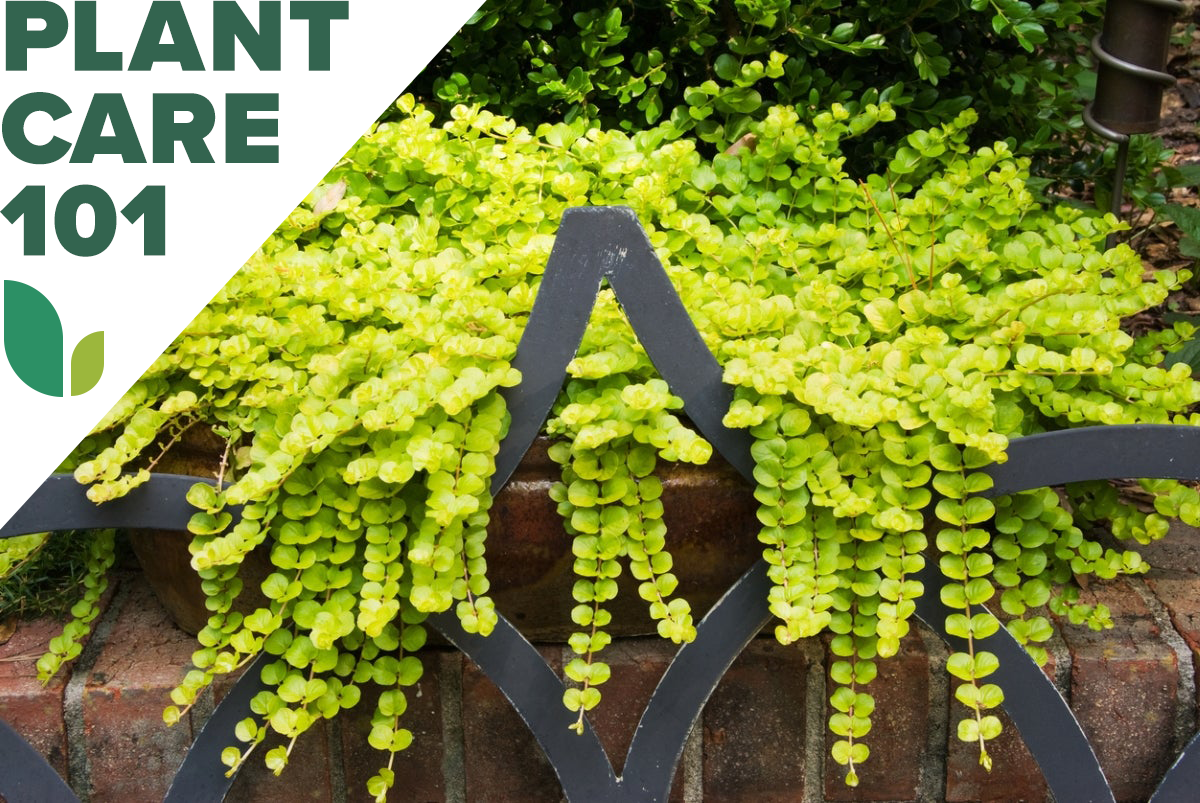We may earn revenue from the products available on this page and participate in affiliate programs. Learn More ›
The yellow or chartreuse cultivars of creeping Jenny, such as ‘Aurea’ and ‘Goldilocks’ types, have become popular as ground covers and spillers for container gardens. However, Lysimachia plants aren’t annuals like most of their container companions; they can return each year in most growing zones.
In fact, the creeping Jenny plant is hardy and vigorous enough to have had its propagation banned in states such as Massachusetts, Delaware, New Hampshire, and Wisconsin due to its invasive nature. Creeping Jenny care is easy, but if you grow this low-maintenance plant, keep it confined to containers or garden beds and away from woodlands or wetlands.
RELATED: The Dos and Don’ts of Planting Ground Cover
Growing Creeping Jenny at a Glance
Common Name: Creeping Jenny, moneywort
Scientific Name: Lysimachia nummularia
Hardiness Zone: USDA zones 3 to 9
Soil: Moist, mildly acidic
Light: Full sun to shade
Water: High
Food: Balanced plant food
Propagation: Division
Safety: Nontoxic
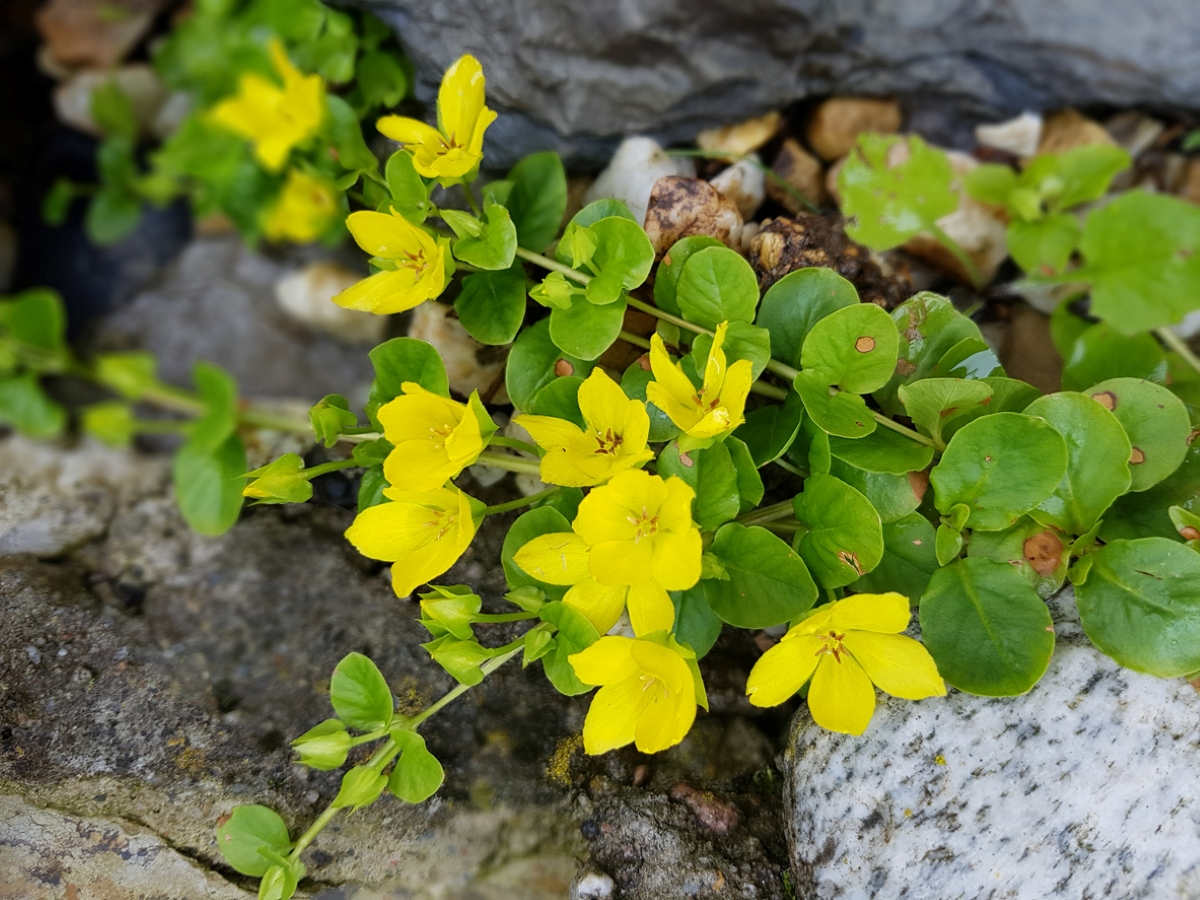
Creeping Jenny Characteristics
The original creeping Jenny, Lysimachia nummularia, grows wild in Europe and Turkey. It has semi-evergreen round leaves that measure ¾ to 1 inch and are cupped, and the ground cover can have yellow ¾- to 1-inch blooms in the leaf axils. It is more invasive than its brighter cultivars, which also produce yellow flowers accompanied by golden or chartreuse foliage. The color of those cultivars is most intense in full sun, running more to green in shade.
The plants creep along the ground, often rooting where their leaf nodes touch the soil. They seldom grow more than 2 to 4 inches tall, but each can spread to 2 feet or more. The flowers on some creeping Jenny varieties appear most heavily in early summer, but not all plants will bloom.
Recommended Creeping Jenny Varieties
- Lysimachia nummularia: The original creeping Jenny’s species name translates to “coin-like” in reference to the shape of its green leaves.
- Lysimachia nummularia ‘Aurea’: Its cultivar name means “golden,” and this type boasts the brightest yellow foliage.
- Lysimachia nummularia ‘Goldilocks’: Named for a fairytale character with a taste for “just right,” this cultivar strikes a balance between yellow and green with chartreuse leaves.
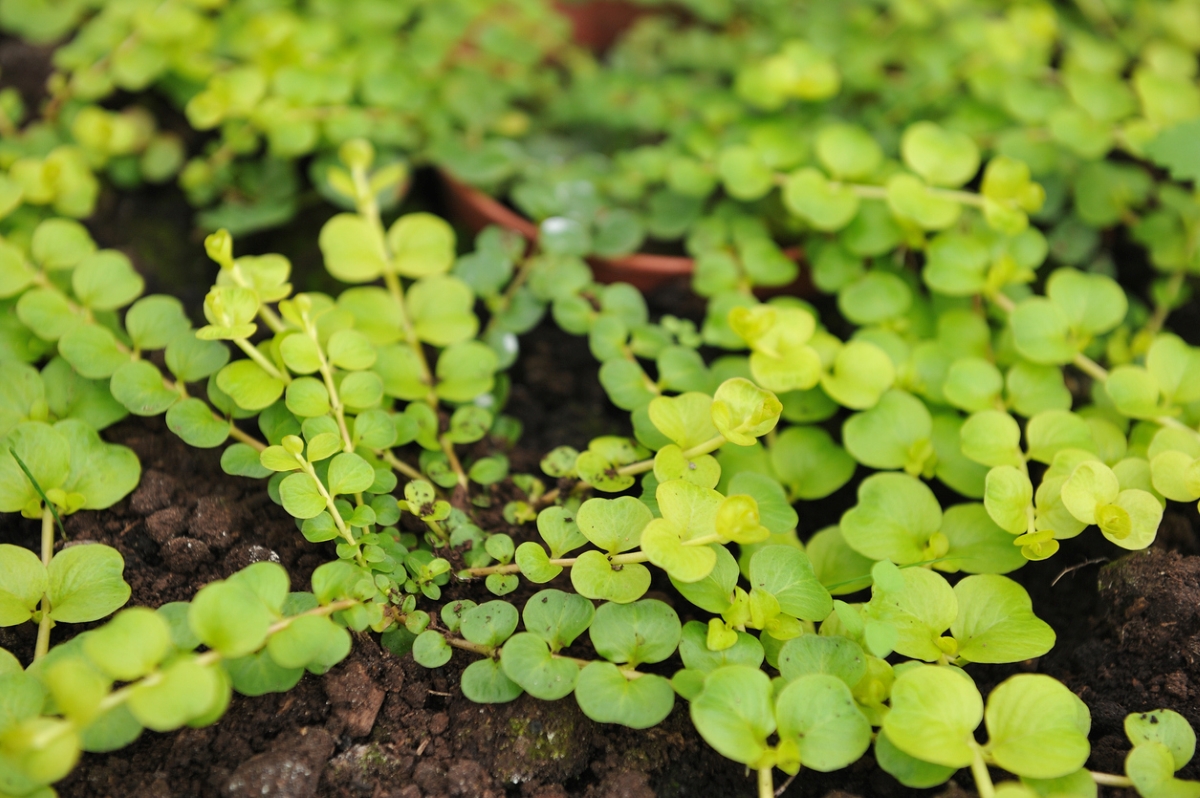
Planting Creeping Jenny
As with seedlings grown under lights, it is a good idea for creeping Jenny care to gradually harden off the perennials grown in greenhouses before you plant them.
When is the best time to plant creeping Jenny?
Although perennial plants will tolerate frost, it’s recommended to plant creeping Jenny just after the last frost in spring, when the soil is still cool. In warmer hardiness zones, you may want to set them out about 6 weeks before the first autumn frost instead. However, fall planting of evergreen (or semi-evergreen) perennials such as this one generally isn’t a good idea in the coldest zones.
Where can creeping Jenny grow?
When planting creeping Jenny, choose a location with moist and slightly acidic soil. Keep in mind that these plants will grow in almost any light exposure from full sun to shade, but the foliage of the cultivars will be the most golden in full sun, and greener in the shade. Creeping Jenny actually can thrive in boggy conditions, so it is a good choice for areas that are too wet for other ground covers.
How do you plant creeping Jenny?
Water creeping Jenny well before you set it in the ground. Then, follow these steps:
- Dig a hole as deep as the root ball of the plant and a couple inches wider than the roots.
- Ease apart any tangled roots and set the root ball in the hole, positioning it so that the plant’s crown is level with the soil surface.
- Backfill soil around its roots.
- If setting out more than one plant, place them 12 to 18 inches apart from each other.
Can you grow creeping jenny in containers?
When growing creeping Jenny in pots, gardeners often combine the low grower with annual flowers to provide contrasting color plus a spiller element. You always want to position spiller plants at the edge of a container or window box so that their foliage dangles over the edge. But keep creeping Jenny away from other low-growing plants, which it could overwhelm.
RELATED: 20 Plants That Are Perfect for Window Boxes
Watering Creeping Jenny
This plant prefers moist soil and can, in fact, grow in boggy ground—and even in aquariums! Therefore, you will want to water it enough that its soil never completely dries out. Ground cover plants growing in shade shouldn’t require frequent irrigation, since their mats of foliage further shade the ground, helping to keep it moist. However, plants packed into containers with other species in full sun might dry out quickly and require watering as often as once per day or more.
Fertilizing Creeping Jenny
When considering how to care for creeping Jenny, keep in mind that it’s already a fast-growing plant—it doesn’t require much encouragement to thrive. Apply a high-nitrogen fertilizer, such as the organic 5-3-2, once in early spring for this ground cover’s first 3 years, using about 2 pounds per 100 square feet. When fully established, it shouldn’t require any more feeding. Fertilize creeping Jenny plants in pots with whatever plant food you are using for the other plants in those containers.
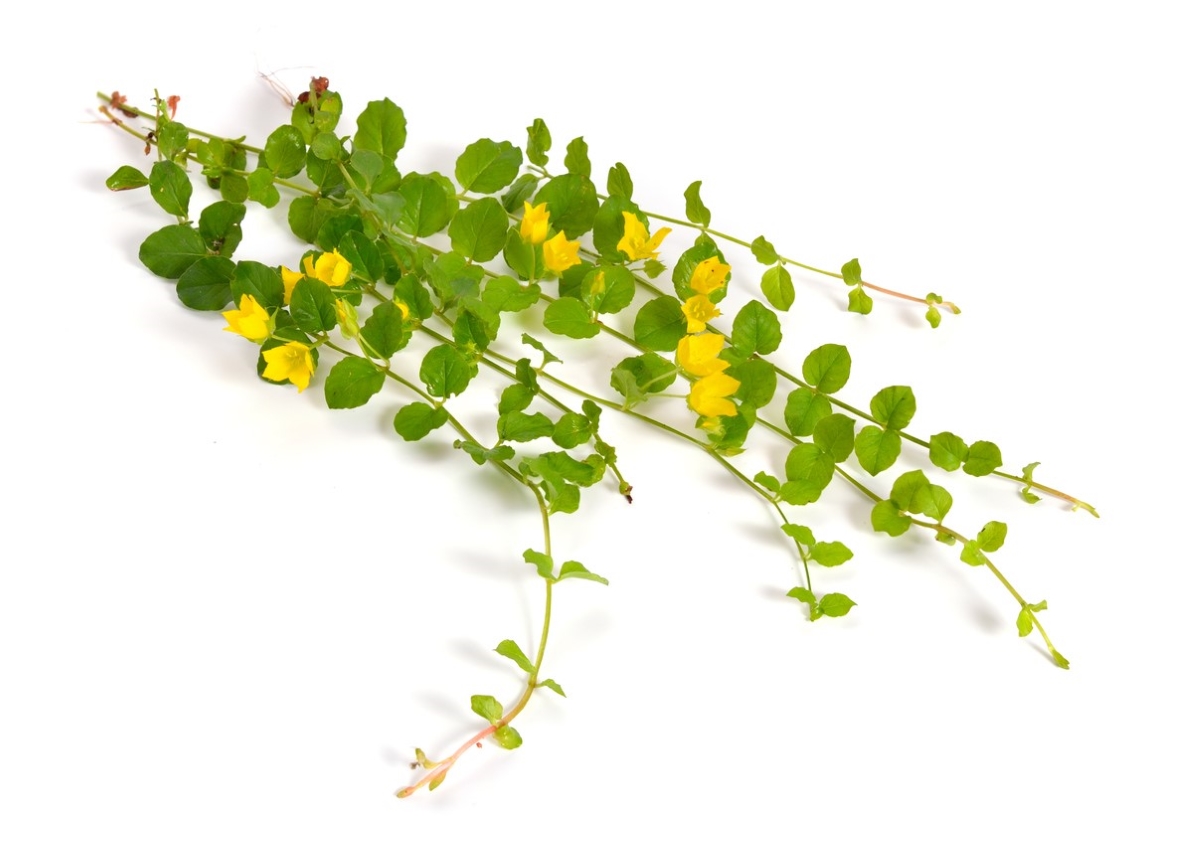
Pruning Creeping Jenny
If you have creeping Jenny cascading over the side of a container, it’s a good idea to snip it back before it touches the ground and begins to root itself there. As has been previously mentioned, this invasive plant is inclined to hit the ground running.
Although creeping Jenny doesn’t often set seed, gardeners who are growing the perennial for its foliage color rather than its blooms may also want to pinch out any buds that form to prevent the plant from flowering. Alternatively, remove those blooms immediately after they fade to forestall the development of seed pods and self-seeding in the landscape or by seeds running off into natural areas.
Propagating Creeping Jenny
Creeping Jenny seeds aren’t readily available but usually aren’t necessary, since (when growing flat on the ground) the plant often roots itself all along the length of its stems. Therefore, creeping Jenny propagation only requires that you dig up some of the rooted pieces, detaching them from the original plant either with the blade of a shovel or with pruning shears.
Propagating creeping Jenny in containers is a little bit different. If the mother plant is sprawling over the edge of a container instead, pin one of its stems down to the soil in the container until the stem roots, after which it can be separated from its parent.
Safety Considerations
Once used in Europe as a medicinal herb, creeping Jenny is a nontoxic plant, so it shouldn’t do any harm to people or animals. However, it can creep over and smother any smaller plants in its path. Therefore, you’ll want to limit its use as a ground cover to places where lower species aren’t growing. To protect the environment, avoid planting creeping Jenny near wetlands and woodlands where it may crowd out less vigorous native plants.
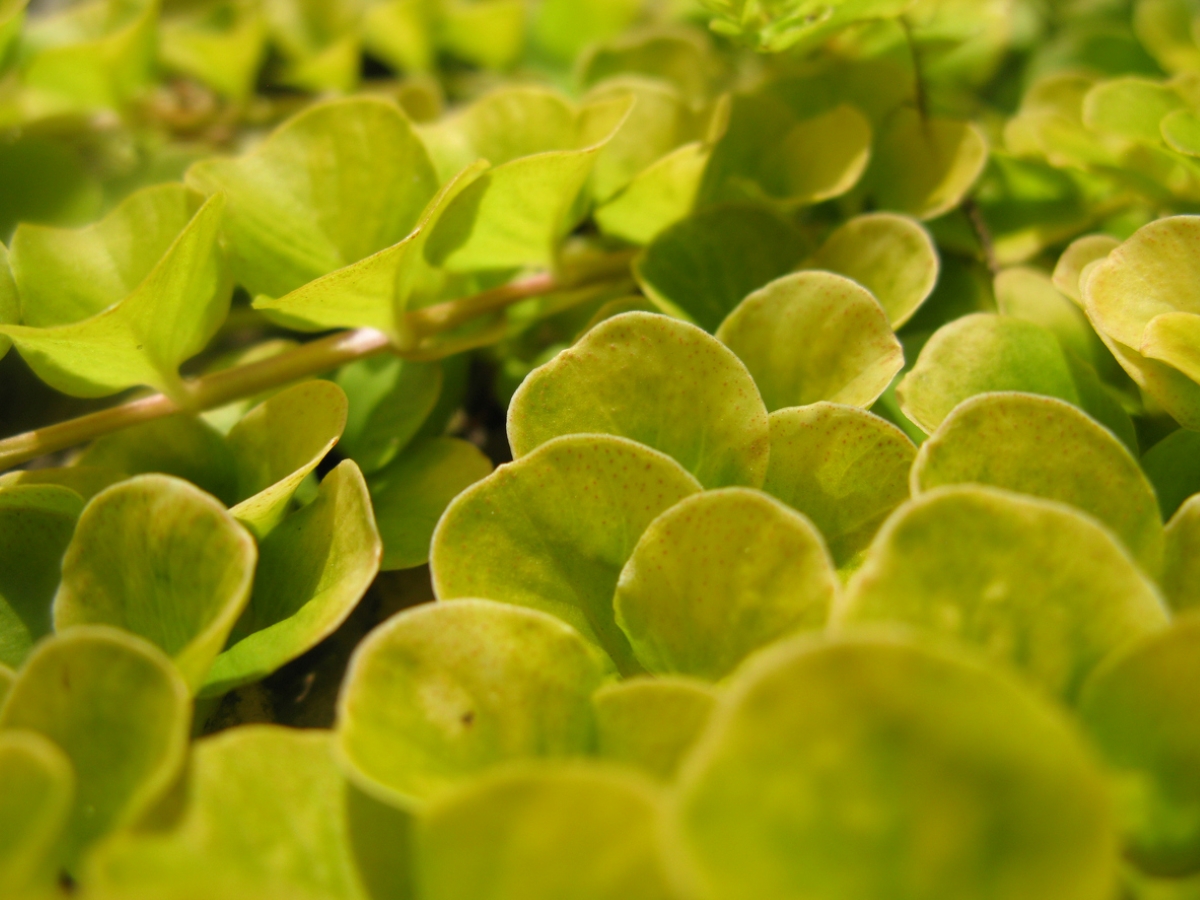
Potential Pests and Diseases
You may see small red spots on creeping Jenny flowers or small black ones on the foliage. Those are natural and nothing to worry about.
Due to its preference for moist locations, the plant’s chief enemy is slugs, which can decimate its foliage. To prevent that, scatter a slug bait containing iron phosphate around the plants late in the evening, applying 1 teaspoon for every square yard of ground, about once every 2 weeks throughout the growing season.
Preparing Creeping Jenny for Winter
Because creeping Jenny is a vigorous species, plants growing in the ground shouldn’t require winter protection. However, perennials left in pots over the cold season need to be hardy to a couple zones north of the one in which they are growing.
Therefore, gardeners in zones 3 and 4 might want to place pots containing creeping Jenny in a sheltered location—such as a garage or shed—over winter. Alternatively, they can take the plants indoors to use as houseplants. There, give them a position in full sun or bright, indirect light and water them frequently enough that their soil never dries out completely.
Looking for more low-maintenance plants? Check out our guides on growing agave, lantana, and purple heart plants.

